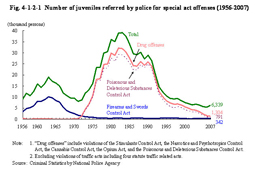| Previous Next Index Image Index Year Selection | |
|
|
1 Number of juveniles referred by the police The number of juveniles referred for special act offenses reached a peak in 1963 (18,967 persons) and then another peak in 1983 (39,062 persons), but after that, has been on a decreasing trend, although it did increase by 16.6% from the previous year in 2007. By type of offense, Firearms and Swords Control Act violations were common from 1955 to 1970, and then drug offenses (violations of the Stimulant Control Act, the Narcotics and Psychotropic Control Act, the Cannabis Control Act, the Opium Act, and the Poisonous and Deleterious Substances Control Act; hereinafter referred to as the same in this section) had a large proportion, but in recent years they have been on a decreasing trend. The number of juveniles referred for Minor Offenses Act violations has been on an increasing trend since 2000 and increased significantly to 2,673 persons (up 64.4% from the previous year) in 2007, accounting for the highest proportion for the two consecutive years at 42.2%. Fig. 4-1-2-1 Number of juveniles referred by police for special act offenses (1956–2007) |
